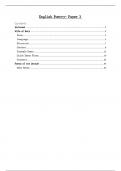English Poetry- Paper 3
Contents
Welcome! .............................................................................................................................................. 2
Wife of Bath .................................................................................................................................... 3
Form .................................................................................................................................................. 3
Language ......................................................................................................................................... 5
Structure........................................................................................................................................ 7
Context ............................................................................................................................................ 8
Example Essay ............................................................................................................................ 15
Quick Essay Plans .................................................................................................................... 19
Summary ........................................................................................................................................ 33
Poems of the Decade .................................................................................................................. 43
Seen Notes .................................................................................................................................... 43
, Welcome!
Welcome to my notes! These were used when I was completing the Poetry module of my A-
Level in English Literature for the Edexcel exam board. I studied ‘The Wife of Bath’ and
‘Poems of the Decade.’ There may be a few spelling errors, but as far as I know everything is
as it should be.
Before we start, here’s the quizlet I made/used alongside these notes:
(https://quizlet.com/fleurcasson/folders/113134120/sets)
I hope you find everything in here useful and get the grades you want!
, Wife of Bath
Form
Poetic Narrative- a form of poetry that tells a story, often using the voices of both a narrator
and character.
Dramatic Monologue- The brief interruptions by other pilgrims remind the reader of this
form.
An Allegorical Confession- This was a medieval genre which plays on morality play
conventions. A personified vice confesses their sins to the audience through a life story
A Work of Rhetoric- Language used to motivate, inspire, inform, or persuade readers and/or
listeners. Was formed in the ancient world but reformed in the Middle Ages to suit religious
purposes, so sermons often had features of rhetoric in them. Aristotle taught logos (reason:
reality, logic, proof), Ethos (character: the creditability of the speaker), and pathos (emotion:
the listeners values and emotions)
A Frame Narrative- a tale in which a larger story contains, or frames, many other stories.
This is what all of the Canterbury tales are.
Conventions of a Frame Narrative
The frame story functions to create a reason for someone to tell the other stories, meaning the
frame story doesn’t have much plot of its own. The subsequent ‘inner’ stories within the
narrative have a clear beginning, middle, and end, and usually fall into their own individual
genres.
In The Canterbury Tales, the pilgrimage to Canterbury provides the frame for the work, and
the device of the storytelling context provides a circumstance for the tales.
Courtly Romance- the chivalric romance is a type of prose and verse narrative that was
popular in the noble courts of High Medieval and Early Modern Europe.
The Wife of Bath was based off of courtly love characters. He combines description taken
from La Duenna Vieille ("The Old Woman") and from La Jaloux ("Jealousy"). Like the Wife
of Bath, La Vieille has been married numerous times, she knows the arts of manipulating
men, and engages in a lengthy confessional revelation of her controlling techniques and
avoiding the potential miseries of marriage. Chaucer’s version of the Wife of Bath also
appears to originate in the French poem, Le Roman de la Rose.
Conventions of a Courtly Romance
Upper class romances that often focused on unrequited love. The male lover would pine and
the woman would be untouchable, being mysterious and occasionally setting her lover
impossible tasks.
They were fantastic stories about marvel-filled adventures, often of a chivalric knight-errant
portrayed as having heroic qualities, who goes on a quest.
Breton lai/narrative lai- a form of medieval French and English romance literature.
, Conventions of a Breton lai
Applicable to the Wife of Bath’s tale.
Lais are short, rhymed tales of love and chivalry, often involving supernatural and fairy-
world Celtic motifs. It’s a short romance that features knights, noble ladies and supernatural
incidents. This kind of tale originated in a northeastern part of France.
The Wife signals that we're about to encounter a story of this genre when she describes King
Arthur as he "of which that the Britons speken greet honour" (864, emphasis ours), and goes
on to fulfill the conventions of the genre.
The Quest Genre- a romantic narrative that follows a pattern of sequential steps: the call to
journey, preparation, the journey, and returning home.
Conventions of a Quest Genre Text
Applicable to the Wife of Bath’s tale.
A protagonist is missing something that he must travel near and far to find, encountering
trials and tribulations along the way. The protagonist is only able to "vanquish" the monster
that stops him from reaching his goal once he shows inner growth. Typically, all ends well.
Here, the protagonist is missing the answer to the queen's question. His trial is that women all
desire different things. The loathly lady he meets at the end of the quest could qualify as a
monster. Consider: she's very, very ugly, and despite helping him to answer the queen's
question, she also prevents the knight from reaching what we presume is his other goal,
marriage to a suitable young damsel. His inner growth is developing a sensitivity to women's
desires.
Exemplum- a story told to illustrate an intellectual idea. In this case, the tale is to provide an
answer to the question "What do women most desire?"
Oral Poetry- Reading was a social activity, as most people weren’t literate. This meant that
Chaucer wrote the Canterbury tales expecting for it to read aloud.
Sermons- The Wife’s Prologue is sermon like in its style. As 95% if society was illiterate
during the 14th century, sermons had to be good, interesting, and full of dramatic storytelling.
The Pardoner in his interruption (line 165) recognises how the Wife is a good preacher.
Conventions of a Sermon
An abstract theme (gluttony, greed, ect) and classical or Biblical parallels and examples
which underline the preacher’s point.
The 100 line digression on ‘gentillesse’ which takes up a quarter of the Tale may seem
strange but it would have been commonplace for a medieval audience who would expect to
hear moral ‘sermoning’.




